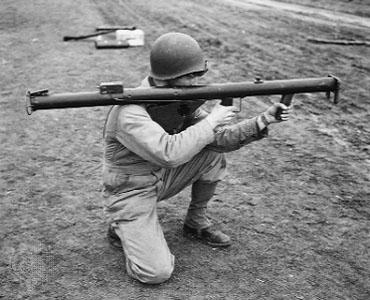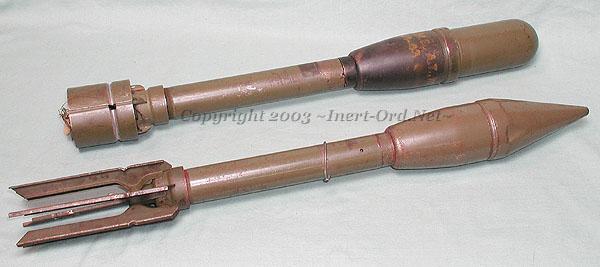2.36-Inch Anti-Tank Rocket M6 Bazooka
The Bazooka was the world's first rocket-propelled anti-tank grenade system. Development began during the beginning of World War II, when it was realized that the U.S. Army had no infantry weapon to combat then modern tanks. The M10 grenade, with a then new hollow-charge warhead, was an effective anti-armour weapon but was too big to be fired from standard anti-tank rifles. The solution was to fit the grenade warhead with a rocket motor, and fire it from a simple tube launcher. This resulted in the 2.36-Inch Anti-Tank Rocket Launcher M1 and the 2.36-inch HEAT (High-Explosive Anti-Tank) Rocket M6. The system quickly earned the nickname Bazooka, which eventually became an official name. The first Bazookas were supplied to Army units in July 1942.
 |
| Photo: National Archives |
| 3.5-Inch Anti-Tank Rocket Launcher M1 |
The M1 launcher was 1.37 m (54 in) long and weighed 8 kg (18 lb). The trigger ignited the solid-propellant rocket motor, which accelerated the M6 rocket to a speed of 82 m/s (270 fps). To protect the gunner, the motor burned out shortly before the rocket left the tube. However, the rocket exhaust was dangerous within a relatively large area behind, and the weapon could not be fired from enclosed positions. The Bazooka could achieve good accuracy up to a range of about 275 m (300 yds).
 |
| Photo: © Inert-Ord.Net |
| From top: M6A3C, M6A1 |
Early reliability problems led to the modification of the electrics in the launcher and rocket, and in July 1943, the modified M1A1 tube and M6A1 rocket were ready for use. The next improvement was the M9 launcher, which consisted of two shorter tubes, which were connected only for firing. This made carrying the system much easier. The M6 and M6A1 rockets had a pointed nose, which led to deflection from the target at low impact angles. Therefore a new M6A3 rocket was designed with a much more blunt nose. The M6A3 also had a new circular fin assembly to improve flight stability. The launcher for the M6A3 was designated M9A1.
The M6A3C rocket was a modification of the M6A3 with a much more sensitive fuze. The M6A3D and M6A3F were identical to the M6A3C, except for different types of propellant. The M6A4 and M6A5 variants were externally identical to the M6A3F, but used different types of fuze. The final version was the M6A6, which was a derivative of the M6A5 with a new fin/nozzle assembly.
The 2.36-inch Practice Rocket M7 was an inert training rocket for the Bazooka. A variety of variants existed, each one to simulate specific variants of the M6 HEAT rockets.
| M7 variant | Simulated M6 variants |
|---|---|
| M7 | M6 |
| M7A1 | M6A1 |
| M7A3 | M6A3, M6A3C |
| M7A4 | M6A3, M6A3C |
| M7A5 | M6A3D |
| M7A6 | M6A3F, M6A4, M6A5 |
| M7A7 | M6A6 |
During the war, the 2.36-inch Bazooka became increasingly ineffective against the latest armour developments. In the post-war years, it was therefore gradually replaced by the larger and more effective 3.5-inch Anti-Tank Rocket M28 ("Super Bazooka").
M6 Derivatives (M10, T27, T31, M26)
The 2.36-inch Smoke Rocket M10 used the rocket motor and fin assembly of the M6A1, but replaced the anti-tank warhead with a white phosphorus (WP) smoke head. WP smoke not only acts as a screen, but its particles can also cause small burns on human skin. The M10 was therefore used to get enemy troops out of holes and dugouts. The M10A1 and M10A2 were identical to the M10 except for different types of propellant. The M10A3 was an M10A2 with a new fuze, but none were actually procured. The final M10A4 was a further modified M10A3, with a new tail assembly and a longer propelling charge, for increased speed and range. The T27E1 was an M10 variant with HC smoke instead of WP.
 |
| Drawing: via ORDATA Website |
| M10 |
The 2.36-inch Incendiary Rocket T31 was an M10 variant with an incendiary warhead, while the 2.36-inch Gas Rocket M26 was an M10A2 derivative with a warhead filled with phosgene.
Specifications
Note: Data given by several sources show slight variations. Figures given below may therefore be inaccurate!
Data for M6 rocket:
| Length | 55 cm (1.8 ft) |
| Diameter | 60 mm (2.36 in) |
| Weight | 1.5 kg (3.3 lb) |
| Speed | 82 m/s (270 fps) |
| Range | 275 m (300 yds) |
| Propulsion | Solid-fueled rocket |
| Warhead | 0.7 kg (1.6 lb) High-explosive |
Main Sources
[1] Frederick I. Ordway III, Ronald C. Wakeford: "International Missile and Spacecraft Guide", McGraw-Hill, 1960
[2] U.S. 2.36" (60mm) H.E.A.T. Rocket
[3] ORDATA Online Website
[4] War Department: "Technical Manual TM9-1950, Rockets", July 1945
[5] Department of the Army: "Technical Manual TM9-1950, Rockets", June 1950
Back to Directory of U.S. Military Rockets and Missiles, Appendix 4
Last Updated: 8 June 2024